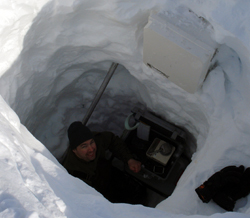DOE - Fossil Energy Techline - Issued on: March 6, 2013
Alaskan Ice Road Water Supplies Augmented by Snow Barriers
Washington, D.C. In a project supported and managed by the Office of Fossil Energy’s National Energy Technology Laboratory (NETL), researchers at the University of Alaska Fairbanks have demonstrated that the use of artificial barrierssnow fencescan significantly increase the amount of fresh water supplies in Arctic lakes at a fraction of the cost of bringing in water from nearby lakes. The results promise to enhance environmentally sound development of Alaska’s natural resources, lowering the costs of building ice roads used for exploring for oil and natural gas in Alaska. They could also be used to help augment fresh water supplies at remote villages.
|
|
|
In the Office of Fossil Energysponsored project, university researchers evaluated the use of snow management and snow barriers to augment lake water supplies. Two lakes with similar hydrological characteristicssuch as precipitation, evaporation, groundwater, and storagewere selected and monitored for 3 years. The researchers left the first lake in its natural regime. At the secondlocated at Franklin Bluffs, 31 miles inland from the coast, in the high-wind and ‑drift zonethey constructed a 300-foot long, 10-foot tall snow barrier to enhance snowdrift formation. During one snow-transport event, 6 feet of snow were added to the drift in just 2 hours. Without the snow barrier, this snow would have either been lost to sublimation or blown and deposited on the tundra or lakes farther from where it is needed.
Snow on the tundra typically melts by the end of May, but drifts by a snow barrier last about a month longer. At Franklin Bluffs, the enhanced drifts provided enough extra water to balance water lost to evaporation during the summer, increasing water volume available in the lake by 2530 percent, despite low rainfall in 2010 and 2011. This totaled an extra 1.5 million gallons of water in 2010 and 1.8 million gallons in 2011, made available at only 1 cent per gallonfar below the 13-cents-per-gallon cost of trucking in water from the nearby town of Deadhorse.
Final data analysis will determine the effect of the snow barrier on snow distribution and sublimation, provide recommendations on snow-barrier location, and evaluate the lake’s hydrological response to snowdrift melt, providing researchers and developers with useful information on snow-control practices. Remote coastal villages, which often depend on snowmelt for their fresh water supplies, should also benefit. Some of these communities, such as the traditional Inupiaq village of Shishmaref, collect fresh water using a similar snow-barrier method. By providing recommendations on snow-barrier location and the cost of additional snowdrift water, results of this and similar studies can help decision makers with water-resources management and assist in mitigating the risks associated with unfavorable climate and hydrological conditions.
The snow-drift and additional-water estimates from the snow-barrier project are now being incorporated into the water-balance model of the North Slope Decision Support System (NSDSS), which is being developed by another research group at University of Alaska Fairbanks with support from the Office of Fossil Energy and NETL. The NSDSS will aid operators and regulatory agencies in the planning of cost-effective ice roads that also minimize environmental impacts to Arctic lakes and tundra.
- End of Techline
|
